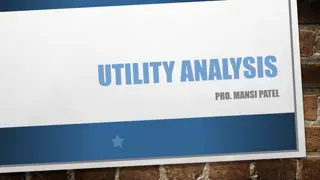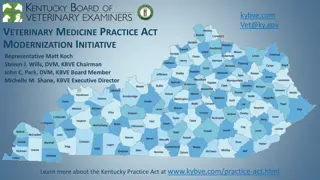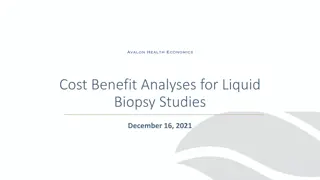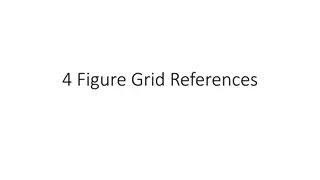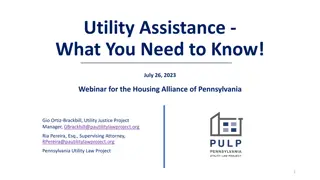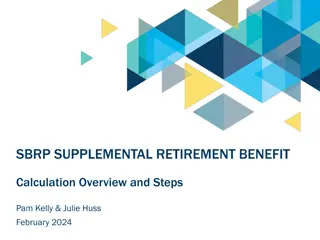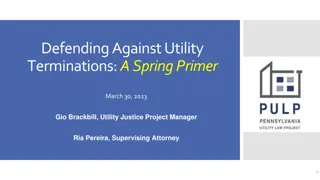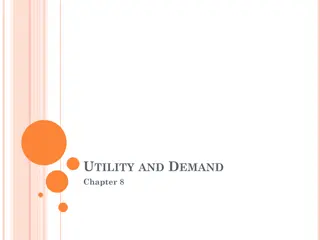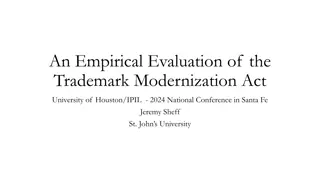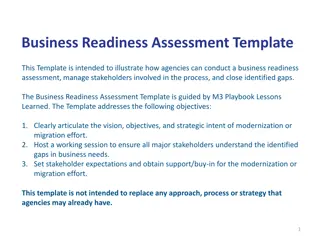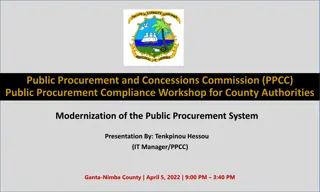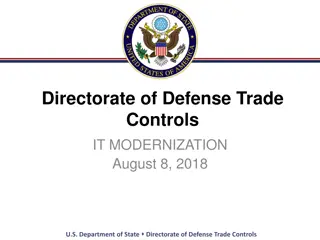Benefit-Cost Analysis for Utility-Facing Grid Modernization Investments
Benefit-Cost Analysis (BCA) plays a crucial role in evaluating utility-facing grid modernization investments. This process involves comparing costs and benefits over the long term, addressing key challenges, and using advanced systems like ADMS to enhance grid operations. The presentation outlines the steps and principles of BCA, emphasizing the need to assess projects in line with policy goals and traditional alternatives.
Download Presentation

Please find below an Image/Link to download the presentation.
The content on the website is provided AS IS for your information and personal use only. It may not be sold, licensed, or shared on other websites without obtaining consent from the author. Download presentation by click this link. If you encounter any issues during the download, it is possible that the publisher has removed the file from their server.
E N D
Presentation Transcript
Synapse Energy Economics, Inc. Benefit-Cost Analysis for Utility-Facing Grid Modernization Investments Tim Woolf, Synapse Energy Economics NASUCA Annual Meeting November 11, 2018 ENERGY TECHNOLOGIES AREA ENERGY ANALYSISAND ENVIRONMENTAL IMPACTS DIVISION
Outline of Presentation Overview of benefit-cost analysis (BCA) in general Key challenges of grid modernization (grid mod) BCA Review of recent utility grid mod proposals Focus on utility-facing grid mod Using Advanced Distribution Management Systems (ADMS) as an example How to address key challenges of grid mod BCAs References for additional information Lots of Q&A throughout 2 ENERGY TECHNOLOGIES AREA ENERGY ANALYSISAND ENVIRONMENTAL IMPACTS DIVISION
Synapse Energy Economics, Inc. OVERVIEW OF BCA & KEY CHALLENGES OF GRID MOD BCA ENERGY TECHNOLOGIES AREA ENERGY ANALYSISAND ENVIRONMENTAL IMPACTS DIVISION
The Role of Benefit-Cost Analysis 1. Case: Utility seeking approval of costs before spending Typically in a case dedicated to review proposed investments Utility often asks for pre-approval Allows for focused review of proposal Utility can be held accountable to cost forecasts Costs can be reduced or rejected before incurred 2. Case: Utility seeking approval of costs after spending Typically in a rate case Allows for review in context of other costs Grid mod issues might be one of many contentious issues Difficult to modify, reduce, or disallow costs 4 ENERGY TECHNOLOGIES AREA ENERGY ANALYSISAND ENVIRONMENTAL IMPACTS DIVISION
Benefit-Cost Analysis Key Steps BCA is used to assess a project by comparing multiple costs with multiple benefits over the long term. Key steps include: 1. Define a reference case/scenario (without the project). 2. Define an alternative case/scenario (with the project). 3. Decide which costs and benefits to include (which test(s) to use). 4. Define all relevant costs and benefits (clarify metrics). 5. Determine appropriate time frame and discount rates. 6. Develop assumptions and input data. 7. Conduct scenario and sensitivity analyses. 8. Present, document, and justify results. 5 ENERGY TECHNOLOGIES AREA ENERGY ANALYSISAND ENVIRONMENTAL IMPACTS DIVISION
Benefit-Cost Analysis Key Principles NSPM (EE) DOE NY PSC (NY REV) Principle (Grid Mod) Assess projects comparably to traditional alternatives Account for applicable policy goals -- Account for all relevant costs & benefits (quant. and qual.) -- Ensure symmetry across relevant costs and benefits -- -- Apply full life-cycle analysis Apply incremental, forward-looking analysis -- -- Ensure transparency Avoid combining or conflating different costs and benefits -- -- Assess bundles & portfolios instead of separate measures -- Address locational and temporal values -- Sources: NESP 2017, DOE 2017, NY PSC 2016. 6 ENERGY TECHNOLOGIES AREA ENERGY ANALYSISAND ENVIRONMENTAL IMPACTS DIVISION
Grid Mod BCAs Key Challenges Challenge Description Differences are not clearly articulated. Alternatives are often bundled too much. Define reference & alternative cases Decide which BCA tests to use (i.e., which costs and benefits to include) Utility system? Policy goals? Society? Consistency with BCAs for other resources? Sometimes requires different metrics (e.g., resilience). Define costs & benefits Time frame & discount rate Utility, regulatory, or societal perspective? Account for qualitative impacts Many benefits are in qualitative terms only. Describe beneficiaries Sometimes unclear who enjoys some benefits. Many benefits depend upon interactions across components Account for interactive effects Proposals frequently do not include information needed to make key decisions. Present, Document, & Justify Results 7 ENERGY TECHNOLOGIES AREA ENERGY ANALYSISAND ENVIRONMENTAL IMPACTS DIVISION
Synapse Energy Economics, Inc. OVERVIEW OF UTILITY-FACING GRID MODERNIZATION PROPOSALS USING ADVANCED DISTRIBUTION MANAGEMENT SYSTEM (ADMS) AS AN EXAMPLE ENERGY TECHNOLOGIES AREA ENERGY ANALYSISAND ENVIRONMENTAL IMPACTS DIVISION
Grid Modernization: Customer Facing Grid Modernization Customer Facing Utility Facing Energy Efficiency Demand Response Distributed Generation Storage Electric Vehicles Advanced Meters Third Party Access Customer Data Cybersecurity 9 ENERGY TECHNOLOGIES AREA ENERGY ANALYSISAND ENVIRONMENTAL IMPACTS DIVISION
Grid Modernization: Utility-Facing Grid Modernization These are referred to here as components Utility Facing Advanced distribution management system (ADMS) Geographic information system (GIS) Distribution system supervisory control and data acquisition (DSCADA) Outage management system (OMS) Distributed energy resource management system (DERMS) Fault location, isolation, & service restoration (FLISR) a/k/a/ dist. automation Volt-var optimization (VVO) Advanced metering infrastructure (AMI) Network monitoring: Substation devices Field (feeder) level devices See Appendix for definitions 10 ENERGY TECHNOLOGIES AREA ENERGY ANALYSISAND ENVIRONMENTAL IMPACTS DIVISION
Advanced Distribution Management Systems (ADMS) A software platform that: Definition of ADMS Integrates several operational components, such as Outage Management System (OMS) Geographic Information System (GIS) Supervisory Control and Data Acquisition (SCADA) Distribution Energy Resource Management (DERMS) Enables advanced components such as Automated fault location, isolation, and service restoration (FLISR) Volt-var optimization (VVO) Distribution State System Estimation (DSSE) Allows for centralized decision-making Optimizes distribution grid performance 11 ENERGY TECHNOLOGIES AREA ENERGY ANALYSISAND ENVIRONMENTAL IMPACTS DIVISION
ADMS Integrates and Enables Many Components ADMS integrates several grid mod components: Detailed network topology Monitor, control, optimize and predict operations Monitor and Operate the Distribution Network GIS Core DMS Applications + Optional Applications e.g., FLISR VVO DSCADA Outage-Related Restoration Activities OMS Two-way communication between customer and utilities Manage a variety of interconnected DER Assets DERMS AMI 12 ENERGY TECHNOLOGIES AREA ENERGY ANALYSISAND ENVIRONMENTAL IMPACTS DIVISION
ADMS Not Always Used With Other Components Utilities that have installed ADMS and use, or plan to use, other components: Not all utilities use all ADMS functions 100% Percent of Utilities Using Application 90% 80% 70% 60% 50% 40% 30% 20% 10% 0% Network Monitoring FLISR VVO DERMS Optimal Feeder Configuraton Protection Coordination Source: Newton-Evans 2017. Based on survey of 29/68 surveyed North American utilities that reported either having or intending to acquire DMS/ADMS in the near future. 13 ENERGY TECHNOLOGIES AREA ENERGY ANALYSISAND ENVIRONMENTAL IMPACTS DIVISION
Key Purported Benefits of ADMS (as claimed in utility filings) Increased Reliability FLISR allows for faster restoration times and enables reduced outage duration and outage frequency Distribution O&M Cost Savings FLISR reduces labor cost through reduced call volumes, reduced truck rolls, and reduced field crew hours VVO reduces asset maintenance costs through reduced capacitor switching DER Integration Increased hosting capacity to accommodate additional DERs; better management of DER resources Energy and Capacity Cost Savings VVO flattens the voltage profile, which enables energy savings, reduces energy losses, and reduces peak demand thereby reducing need for generation and T&D capacity infrastructure Increased DER Integration can avoid both energy and capacity related costs Improved Distribution System Planning DSSE and Advanced Power Flows provide visibility into the grid and allow for better distribution system planning 14 ENERGY TECHNOLOGIES AREA ENERGY ANALYSISAND ENVIRONMENTAL IMPACTS DIVISION
Additional Benefits of ADMS (as claimed in utility filings) Increased Customer Satisfaction Through reduced outage duration and frequency Increased Safety Through reduced exposure of field crew due to reduced outages and increased automation Environmental Benefits Primarily from increased DER integration Improved Power Quality Through reduced voltage sags and swells due to more accurate grid optimization Improved Resilience Through reduced vulnerability to storm outages Economic Development and Job Creation From reduced customer bills as a result of utility cost savings 15 ENERGY TECHNOLOGIES AREA ENERGY ANALYSISAND ENVIRONMENTAL IMPACTS DIVISION
Synapse Energy Economics, Inc. REVIEW OF SAMPLE UTILITY-FACING GRID MODERNIZATION PROPOSALS ENERGY TECHNOLOGIES AREA ENERGY ANALYSISAND ENVIRONMENTAL IMPACTS DIVISION
Recent Grid Mod Proposals Including ADMS Utility Unitil (MA) Eversource (MA) National Grid (MA) National Grid (NY) NYSEG (NY) & RGE (NY) PSCo (CO) SDGE (CA) APS (AZ) FirstEnergy (OH) Xcel (MN) Vectren (IN) DTE Electric (MI) Consumers Energy (MI) PSEG (NJ) LGE (KY) Central Hudson (NY) National Grid (RI) Year 2015 2015 2016 2016 2016 2016 2016 2016 2017 2017 2017 2017 2017 2018 2018 2018 2018 We reviewed 22 grid modernization proposals. Of those, 17 proposals included ADMS. 17 ENERGY TECHNOLOGIES AREA ENERGY ANALYSISAND ENVIRONMENTAL IMPACTS DIVISION
High-Level Trends in Utility-Facing Grid Mod Proposals Wide variety in grid mod components proposed Almost all proposals include monetary estimates of costs All proposals claim qualitative benefits Few proposals offer methodologies for how to account for qualitative benefits In the absence of qualitative benefits, some proposals are not cost-effective Few proposals provide monetized results for grid mod components in isolation Including ADMS in isolation Few proposals even provide monetized results for portfolios 18 ENERGY TECHNOLOGIES AREA ENERGY ANALYSISAND ENVIRONMENTAL IMPACTS DIVISION
Deployment, Enhancement, & Integration of Components Utility National Grid NYSEG & RGE Unitil National Grid Eversource PSCo Xcel FirstEnergy Vectran National Grid DTE Electric APS PSEG Consumers Energy LGE SDG&E CHG&E State NY NY MA MA MA CO MN OH IN RI MI AZ NJ MI KY CA NY GIS E E I E I E E E I E DSCADA E E ` E E I E OMS E E I E I I D ADMS D E D D D I D D D D D E D D Enhancement and Integration Deployment and Integration Integration Only No Specific Proposal These results are based upon a brief review of utility proposals, and are meant for illustrative purposes only. In certain cases, it was not clear whether the technology has already been implemented or the degree of integration proposed. E E E E I E E I E D E E D D E E I I E E E E E This table includes components that ADMS can help integrate. 19 ENERGY TECHNOLOGIES AREA ENERGY ANALYSISAND ENVIRONMENTAL IMPACTS DIVISION
Deployment, Enhancement, & Integration of Components FLISR D E VVO D E D D D D E Utility National Grid NYSEG & RGE Unitil National Grid Eversource PSCo Xcel FirstEnergy Vectran National Grid DTE Electric APS PSEG Consumers Energy LGE SDG&E CHG&E State NY NY MA MA MA CO MN OH IN RI MI AZ NJ MI KY CA NY AMI D D I D DERMS D D D Enhancement and Integration Deployment and Integration Integration Only D D D D No Specific Proposal D D These results are based upon a brief review of utility proposals, and are meant for illustrative purposes only. In certain cases, it was not clear whether the technology has already been implemented or the degree of integration proposed. D D D D D D D D D D D I I I E E E E This table includes components that ADMS can help enable. 20 ENERGY TECHNOLOGIES AREA ENERGY ANALYSISAND ENVIRONMENTAL IMPACTS DIVISION
Frequency of Claimed Grid Mod Benefits Frequency of benefits related to ADMS, including monetized and non-monetized. From 17 Grid Mod proposals reviewed. Reliability Distribution O&M DER Integration Energy & Generation Capacity System Planning Customer Satisfaction Safety Environmental Power Quality Other Benefits Resilience (Storm Restoration) Percent of studies claiming benefit Economic Development 0% 20% 40% 60% 80% 100% Other Benefits includes acceleration of future beneficial technology (National Grid MA), and customer empowerment (LGE KY). 21 ENERGY TECHNOLOGIES AREA ENERGY ANALYSISAND ENVIRONMENTAL IMPACTS DIVISION
Frequency of Claimed Monetized Benefits Frequency of Monetized Benefits in Proposals Where Benefits Related to ADMS are Monetized Of the 17 proposals, only 9 provided any form of monetized benefits related to ADMS. Most of the monetized benefits are for energy and capacity, and reliability. Percent of studies claiming benefit 22 ENERGY TECHNOLOGIES AREA ENERGY ANALYSISAND ENVIRONMENTAL IMPACTS DIVISION
Grid Mod Benefit Cost Results - Monetized Benefit-cost ratios from the 9 proposals that provided any form of monetized benefits. Unmonetized benefits are not included here. Proposals typically do not present benefit-cost ratios, because they do not include the non- monetized benefits. Portfolio Benefit-Cost Ratios 23 ENERGY TECHNOLOGIES AREA ENERGY ANALYSISAND ENVIRONMENTAL IMPACTS DIVISION
Example: PSE&G Storm Hardening Results Purported Costs and Benefits for Entire Storm Hardening Proposal $1,800 PSE&G Provides Monetized Values for All Benefits $1,600 Resilience Costs or Benefits (Millions of PV Dollars) $1,400 Communications ADMS $1,200 Reclosing Sectionalization Hardening $1,000 Spacer Cable $800 $600 Substation Upgrades Reliability $400 Station Flood and Storm Surge $200 Day to Day Cost Reductions $0 Costs Benefits 24 ENERGY TECHNOLOGIES AREA ENERGY ANALYSISAND ENVIRONMENTAL IMPACTS DIVISION
Example: Grid BCA Results Purported Costs and Benefits for Entire Grid Mod Portfolio Proposal $400 Unmonetized Benefits The unmonetized benefits must exceed this much for the investment to be cost-effective $350 25 System Planning Distribution O&M DER Integration Customer Satisfaction Qualitative Benefits Millions of Dollars (NPV) $300 VVO $250 Electricity Cost Savings $200 FLISR With Monetized Benefits Only: BCR = 0.74 $150 Reliability $100 ADMS System Optimization $50 $- Costs Benefits 25 ENERGY TECHNOLOGIES AREA ENERGY ANALYSISAND ENVIRONMENTAL IMPACTS DIVISION
Example: ADMS Benefit-Cost Results Only 2 proposals provide monetized results for ADMS project in isolation. With very different results. Differences probably due to how benefits are characterized. Unmonetized benefits are not included in graph. Claimed Benefit-Cost Ratios for Portfolios and ADMS in isolation 4.5 4.0 3.5 Benefit-Cost Ratio (BCR) 3.0 2.5 2.0 1.5 Portfolio BCR ADMS BCR 1.0 0.5 0.0 PSEG (NJ) Unitil (MA) 26 ENERGY TECHNOLOGIES AREA ENERGY ANALYSISAND ENVIRONMENTAL IMPACTS DIVISION
Synapse Energy Economics, Inc. HOW TO ADDRESS KEY GRID MOD BCA CHALLENGES ENERGY TECHNOLOGIES AREA ENERGY ANALYSISAND ENVIRONMENTAL IMPACTS DIVISION
Grid Mod BCAs Key Challenges Challenge Description Differences are not clearly articulated. Alternatives are often bundled too much. Define reference & alternative cases Decide which BCA tests to use (i.e., which costs and benefits to include) Utility system? Policy goals? Society? Consistency with BCAs for other resources? Sometimes requires different metrics (e.g., resilience). Define costs & benefits Time frame & discount rate Utility, regulatory, or societal perspective? Account for qualitative impacts Many benefits are in qualitative terms only. Describe beneficiaries Sometimes unclear who enjoys some benefits. Many benefits depend upon interactions across components Account for interactive effects Proposals frequently do not include information needed to make key decisions. Present, Document, & Justify Results 28 ENERGY TECHNOLOGIES AREA ENERGY ANALYSISAND ENVIRONMENTAL IMPACTS DIVISION
Define Cases: Full Description and Justification This issue can mostly be addressed with robust filing requirements. The initial filing should clearly articulate: what already exists on the system what would exist in a future without the proposed investment what the proposed investments will be Feature Reference Case Alternative Case ADMS Not Included Included Localized Decision Making Centralized Decision Making Decision Making Decisions based on substation data only Decisions based on substation data and feeder level data Upgrade and refinement of GIS data to ensure accurate network connectivity between assets GIS No change to GIS model 29 ENERGY TECHNOLOGIES AREA ENERGY ANALYSISAND ENVIRONMENTAL IMPACTS DIVISION
Define Cases: Full Description and Justification Feature Reference Case Alternative Case DSCADA capabilities deployed to all feeder level assets DSCADA capabilities not deployed to feeder level assets DSCADA Upgraded DSCADA system to handle large amounts of data Limited DER Integration DERMS integrated with ADMS DERMS No DERMS AMI Limited AMI deployment Increased AMI deployment Based on Substation Data only Based on Substation and Feeder Level data VVO Automated FLISR Not Included Included Substation Automation Level only Substation and Feeder Level Automation Automation 30 ENERGY TECHNOLOGIES AREA ENERGY ANALYSISAND ENVIRONMENTAL IMPACTS DIVISION
BCA Tests: Decide Which Costs and Benefits to Include Which test (i.e., perspective) is most important: Utility System Perspective Impact on utility system (Utility Cost test) Societal Perspective Impact on utility system and society in general (Societal Cost test) Regulatory Perspective Impact on utility system and state energy goals (state specific test) This decision should ideally be made by regulators, with stakeholder input, prior to proposals being filed. 31 ENERGY TECHNOLOGIES AREA ENERGY ANALYSISAND ENVIRONMENTAL IMPACTS DIVISION
BCA Tests: California Standard Practice Manual The CA Manual has been universally used for energy efficiency Describes five standard cost-effectiveness tests: Utility Cost test: impacts on the utility system Total Resource Cost test: impacts on utility system and participants Societal Cost test: impacts on society Participant test: impacts on program participants Rate Impact Measure test: impacts on rates These tests are increasingly being used to assess grid modernization, DERs, and related initiatives. But the CA Manual does not address current needs: Does not address energy policy goals Has been interpreted inconsistently Does not address some key DER issues 32 ENERGY TECHNOLOGIES AREA ENERGY ANALYSISAND ENVIRONMENTAL IMPACTS DIVISION
BCA Tests: National Standard Practice Manual 1. Designed to update, improve, and replace the California SPM 2. Includes a set of fundamental BCA principles 3. Identifies the importance of accounting for policy goals in BCAs This is a key concept missing from the California SPM 4. Introduces the regulatory perspective Which reflects the overarching goals of providing customers with safe, reliable, low-cost energy services while meeting applicable policy goals 5. Articulates that there are multiple ways to develop a BCA test States are not limited to the Utility, the Total Resource, or the Societal Cost tests A test can include some societal benefits, but not necessarily all 6. Provides a framework for determining a state BCA test The primary test used in a state to determine whether benefits exceed costs. Might be one of the traditional tests, or might be a new one 33 ENERGY TECHNOLOGIES AREA ENERGY ANALYSISAND ENVIRONMENTAL IMPACTS DIVISION
BCA Tests: EPRI: Benefit-Cost Framework for the Integrated Grid EPRI report explains the rationale for both the utility and societal perspectives There is no mention of a Total Resource Cost test Source: Electric Power Research Institute, 2015, pages 9-3. 34 ENERGY TECHNOLOGIES AREA ENERGY ANALYSISAND ENVIRONMENTAL IMPACTS DIVISION
BCA Tests: U.S. Department of Energy: Modern Distribution Grid DOE report divides modern grid expenditures into four types: Type of Expenditure BCA Approach Apply a best-fit / least-cost approach. Similar to the Utility Cost test. To replace aging infrastructure Apply a best-fit / least-cost approach. Similar to the Utility Cost test. To maintain reliable operations To enable public policy or societal benefits Apply a Societal Cost test No need for utilities or regulators to conduct a BCA. Expenditures paid for by customers Concerns: (a) requires distinguishing by category; (b) results in inconsistent tests across projects/components/resources. Source: US Department of Energy, 2017, pages 39-44. 35 ENERGY TECHNOLOGIES AREA ENERGY ANALYSISAND ENVIRONMENTAL IMPACTS DIVISION
BCA Tests: General Trends Increased flexibility in choice of tests/perspectives Increased emphasis on: Utility system impacts Accounting for policy goals Societal impacts Less emphasis on: The Total Resource Cost test Rate impacts (except for DERs that reduce sales) Increased need for consistency: Across DERs Across utility investments 36 ENERGY TECHNOLOGIES AREA ENERGY ANALYSISAND ENVIRONMENTAL IMPACTS DIVISION
BCA Tests: Recommendations Decide upon test(s) prior to filing of grid mod proposal. Use stakeholder input to decide upon tests The primary test should reflect the state s energy policy goals. The same BCA tests should be applied to all types of utility investments. Conduct multiple tests: Utility system perspective: Should be used in all grid mod proposals Best reflection of impacts on total costs and average bills Regulatory perspective Best reflection of energy policy goals 37 ENERGY TECHNOLOGIES AREA ENERGY ANALYSISAND ENVIRONMENTAL IMPACTS DIVISION
Define Costs & Benefits: Examples of Challenging Metrics Metric Definition Reliability Maintain the delivery of electric services to customers in the face of routine uncertainty in operation conditions. Resilience The ability to prepare for and adapt to changing conditions and withstand and recover rapidly from major disruptions. Flexibility The ability of the grid to respond to future uncertainties that stress the system in the short-term and may require the system to adapt over time. Sustainability The provision of electric services to customers while minimizing negative impacts on humans and the natural environment. Affordability The ability of the system to provide electric services at a cost less than customers willingness and ability to pay for them. Security The ability to resist external disruptions to the energy supply infrastructure caused by intentional physical or cyber attacks or by limited access to critical materials from hostile countries. Source: Grid Mod Consortium 2017 38 ENERGY TECHNOLOGIES AREA ENERGY ANALYSISAND ENVIRONMENTAL IMPACTS DIVISION
Define Costs & Benefits: Examples from NJ Definition of Reliability, Resiliency, and Hardening Investments Reliability Resilience Hardening Mitigate outages during blue sky conditions Mitigate outages during disruptive events such as storms, floods, etc. Mitigate outages during disruptive events such as storms, floods, etc. Reduce outage duration and frequency Reduce outage duration Reduce outage frequency Enable facilities to continue running Promote a faster return to normal operations after a disruptive event Make the grid less susceptible to disruptive events such as storms, floods, etc. 39 ENERGY TECHNOLOGIES AREA ENERGY ANALYSISAND ENVIRONMENTAL IMPACTS DIVISION
Time Frame: Recommendations Filing requirements should: Articulate the study period (# years). Explain how the study period was determined. Justify the choice of study period. The time frame (i.e., study period) should include the full lifetime of the last project/component installed. If a component is installed in 2025 and has an estimated operating life of 15 years, the study should go through 2040 (even though impacts in later years have less impact). This issue should be decided and resolved prior to the grid mod proposal. 40 ENERGY TECHNOLOGIES AREA ENERGY ANALYSISAND ENVIRONMENTAL IMPACTS DIVISION
Discount Rate: Impacts can be Significant The choice of discount rate will have a large impact on the costs and benefits. 41 ENERGY TECHNOLOGIES AREA ENERGY ANALYSISAND ENVIRONMENTAL IMPACTS DIVISION
Discount Rate: Several Options The discount rate reflects a particular time preference. The relative importance of short- versus long-term impacts. Utility weighted average cost of capital (WACC) is widely used in Grid Mod and other BCAs Examples of discount rates Investor-owned utility WACC: 5%-8% Publicly-owned utility WACC: 3%-5% Utility customers: Varies widely Low risk: 0%-3% Societal: <0%-3% 42 ENERGY TECHNOLOGIES AREA ENERGY ANALYSISAND ENVIRONMENTAL IMPACTS DIVISION
Discount Rate: Limitations to Using the Utility WACC The goal of BCAs for unregulated business is different from the goal of BCAs in regulatory settings: For unregulated businesses, the goal of BCA is to maximize shareholder value. Investors time preference is driven entirely by investors opportunity cost and risk, and the WACC reflects both of those. For regulated utilities, the goal of BCA is fundamentally different: The goal is to provide safe, reliable, low-cost power to customers and meet policy goals. The goal is not to maximize shareholder value. Since the goal for a regulated utility is different, the time preference is also different. 43 ENERGY TECHNOLOGIES AREA ENERGY ANALYSISAND ENVIRONMENTAL IMPACTS DIVISION
Discount Rate: Recommendations (I) The choice of discount rate is a policy decision. The discount rate should reflect the time preference chosen by regulators on behalf of all customers. In other words, should reflect the regulatory perspective The regulatory perspective should account for many factors: low-cost, safe, reliable service; intergenerational equity; other state or regulatory policy goals. The regulatory perspective suggests a greater emphasis on long-term impacts than what is reflected in the WACC. Which implies a lower discount rate. 44 ENERGY TECHNOLOGIES AREA ENERGY ANALYSISAND ENVIRONMENTAL IMPACTS DIVISION
Discount Rate: Recommendations (II) Each state should choose a discount rate that reflects its own time preference and policy objectives. The same discount rate should be used in all utility BCAs: Grid modernization, DERs, IRP, distribution system planning Sensitivities can be helpful. For example: Use the utility WACC as a high case. Use a low-risk or societal discount rate as a low case. 45 ENERGY TECHNOLOGIES AREA ENERGY ANALYSISAND ENVIRONMENTAL IMPACTS DIVISION
Discount Rate: Sensitivity Analysis 500,000 450,000 Discount Rate = 7% 400,000 350,000 Cost or Benefit ($1000) 300,000 Net Benefits = $64 mil BCR = 1.3 250,000 200,000 150,000 100,000 50,000 0 2019 2020 2021 2022 2023 2024 2025 2026 2027 2028 2029 2030 2031 2032 2033 2034 2035 2036 2037 2038 Costs Benefits $500,000 $450,000 $400,000 Discount Rate = 2% Cost or Benefit ($1000) $350,000 $300,000 Net Benefits = $234 mil BCR = 1.9 $250,000 $200,000 $150,000 $100,000 $50,000 $0 2019 2028 Benefits 2020 2021 2022 2023 2024 2025 2026 2027 2029 2030 2031 2032 2033 2034 2035 2036 2037 2038 Costs 46 ENERGY TECHNOLOGIES AREA ENERGY ANALYSISAND ENVIRONMENTAL IMPACTS DIVISION
Interactive Effects: Apply Scenarios Filing requirements should include full description and explanation of how the different components interact. Proposal should present BCA results for each component in isolation. Unless the utility can justify otherwise for some components. Proposal should also present BCA results for different combinations of components. Especially of components that are most inter-dependent. Selection of grid modernization portfolio should be justified using the results of the different scenarios. 47 ENERGY TECHNOLOGIES AREA ENERGY ANALYSISAND ENVIRONMENTAL IMPACTS DIVISION
Interactive Effects: Example Small Bundle Bundle includes ADMS plus components that it integrates (GIS, DSCADA, and OMS). ADMS GIS DSCADA OMS Portfolio Monetary Impacts Benefits (PV$) 14 0.4 0 4 18.4 Costs (PV$) 10 1 2 3 16 Net Benefits (PV$) 4 -0.6 -2 1 2.4 Benefit-Cost Ratio 1.4 0.4 0.0 1.3 1.2 These are hypothetical values for illustrative purposes only. GIS, DSCADA, and OMS benefits include benefits expected in the absence of ADMS, and the ADMS benefits reflect incremental benefits accruing from those other components. 48 ENERGY TECHNOLOGIES AREA ENERGY ANALYSISAND ENVIRONMENTAL IMPACTS DIVISION
Interactive Effects: Example Intermediate Bundle Add FLISR and DERMS to the Small Bundle. ADMS GIS DSCADA OMS FLISR DERMS Portfolio Monetary Impacts Benefits (PV$) 18 0.4 0 4 4 1 27.4 Costs (PV$) 10 1 2 3 3.3 1.2 20.5 Net Benefits (PV$) 8 -0.6 -2 1 0.7 -0.2 6.9 Benefit-Cost Ratio 1.8 0.4 0.0 1.3 1.2 0.8 1.3 These are hypothetical values for illustrative purposes only. GIS, DSCADA, and OMS benefits include benefits expected in the absence of ADMS, and the ADMS benefits reflect incremental benefits accruing from those other components. 49 ENERGY TECHNOLOGIES AREA ENERGY ANALYSISAND ENVIRONMENTAL IMPACTS DIVISION
Interactive Effects: Example Full Bundle Add AMI and VVO to the Intermediate Bundle. ADMS GIS DSCADA OMS FLISR DERMS AMI VVO Portfolio Monetary Impacts Benefits (PV$) 20 0.4 0 4 4 1 10 3 39.4 Costs (PV$) 10 1 2 3 3.3 1.2 13 2 33.5 Net Benefits (PV$) 10 -0.6 -2 1 0.7 -0.2 -3 1 5.9 Benefit-Cost Ratio 2.0 0.4 0.0 1.3 1.2 0.8 0.8 1.5 1.2 These are hypothetical values for illustrative purposes only. GIS, DSCADA, and OMS benefits include benefits expected in the absence of ADMS, and the ADMS benefits reflect incremental benefits accruing from those other components. 50 ENERGY TECHNOLOGIES AREA ENERGY ANALYSISAND ENVIRONMENTAL IMPACTS DIVISION






